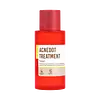What's inside
What's inside
 Key Ingredients
Key Ingredients

 Benefits
Benefits

 Ingredients Side-by-side
Ingredients Side-by-side

Water
Skin ConditioningGluconolactone
Skin ConditioningAnnona Cherimola Fruit Extract
Skin ConditioningButylene Glycol
HumectantPhenoxyethanol
PreservativePolyglyceryl-4 Caprate
EmulsifyingTriethanolamine
BufferingDisodium EDTA
Ethylhexylglycerin
Skin ConditioningSodium Citrate
BufferingPentylene Glycol
Skin ConditioningPhenylpropanol
MaskingSodium Dehydroacetate
PreservativeMadecassoside
AntioxidantMethyl Diisopropyl Propionamide
MaskingCitric Acid
BufferingCamellia Sinensis Leaf Water
MaskingButylene Glycol
HumectantPolyglyceryl-4 Caprate
EmulsifyingWater
Skin ConditioningTriethanolamine
BufferingPhenoxyethanol
PreservativeGlycerin
HumectantEthylhexylglycerin
Skin ConditioningHippophae Rhamnoides Fruit Extract
Skin ConditioningBacillus/Folic Acid Ferment Filtrate Extract
AntioxidantPentylene Glycol
Skin ConditioningMethyl Diisopropyl Propionamide
MaskingSodium Hyaluronate
HumectantZinc Sulfate
Antimicrobial1,2-Hexanediol
Skin ConditioningCamellia Sinensis Leaf Water, Butylene Glycol, Polyglyceryl-4 Caprate, Water, Triethanolamine, Phenoxyethanol, Glycerin, Ethylhexylglycerin, Hippophae Rhamnoides Fruit Extract, Bacillus/Folic Acid Ferment Filtrate Extract, Pentylene Glycol, Methyl Diisopropyl Propionamide, Sodium Hyaluronate, Zinc Sulfate, 1,2-Hexanediol
 Reviews
Reviews

Ingredients Explained
These ingredients are found in both products.
Ingredients higher up in an ingredient list are typically present in a larger amount.
Butylene Glycol (or BG) is used within cosmetic products for a few different reasons:
Overall, Butylene Glycol is a safe and well-rounded ingredient that works well with other ingredients.
Though this ingredient works well with most skin types, some people with sensitive skin may experience a reaction such as allergic rashes, closed comedones, or itchiness.
Learn more about Butylene GlycolEthylhexylglycerin (we can't pronounce this either) is commonly used as a preservative and skin softener. It is derived from glyceryl.
You might see Ethylhexylglycerin often paired with other preservatives such as phenoxyethanol. Ethylhexylglycerin has been found to increase the effectiveness of these other preservatives.
We don't have a description for Methyl Diisopropyl Propionamide yet.
Pentylene glycol is typically used within a product to thicken it. It also adds a smooth, soft, and moisturizing feel to the product. It is naturally found in plants such as sugar beets.
The hydrophilic trait of Pentylene Glycol makes it a humectant. As a humectant, Pentylene Glycol helps draw moisture from the air to your skin. This can help keep your skin hydrated.
This property also makes Pentylene Glycol a great texture enhancer. It can also help thicken or stabilize a product.
Pentylene Glycol also acts as a mild preservative and helps to keep a product microbe-free.
Some people may experience mild eye and skin irritation from Pentylene Glycol. We always recommend speaking with a professional about using this ingredient in your routine.
Pentylene Glycol has a low molecular weight and is part of the 1,2-glycol family.
Learn more about Pentylene GlycolPhenoxyethanol is a preservative that has germicide, antimicrobial, and aromatic properties. Studies show that phenoxyethanol can prevent microbial growth. By itself, it has a scent that is similar to that of a rose.
It's often used in formulations along with Caprylyl Glycol to preserve the shelf life of products.
Polyglyceryl-4 Caprate comes from Capric Acid and Polyglycerin-4. It is an emulsifier.
Emulsifiers help stabilize a product. They do this by preventing ingredients from separating, such as oils and water which do not mix naturally.
Triethanolamine is an emulsifier and pH adjuster. It is created using ethylene oxide and ammonia. This gives Triethanolamine a nitrogen core and a similar scent to ammonia.
As an emulsifier, it prevents ingredients from separating and enhances texture by adding volume to a product.
PH adjusters are common in cosmetic products. The pH of a product can affect the effectiveness of other ingredients. A product with a high pH may also irritate the skin.
Learn more about TriethanolamineWater. It's the most common cosmetic ingredient of all. You'll usually see it at the top of ingredient lists, meaning that it makes up the largest part of the product.
So why is it so popular? Water most often acts as a solvent - this means that it helps dissolve other ingredients into the formulation.
You'll also recognize water as that liquid we all need to stay alive. If you see this, drink a glass of water. Stay hydrated!
Learn more about Water